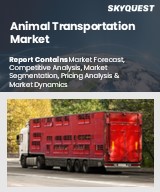
Report ID: SQMIG20R2062
Skyquest Technology's expert advisors have carried out comprehensive research on the animal transportation market to identify the major global and regional market trends and growth opportunities for leading players and new entrants in this market. The analysis is based on in-depth primary and secondary research to understand the major market drivers and restraints shaping the future development and growth of the industry.
Rising global demand for animal products
Expanding pet industry and rising pet ownership rates
Stringent regulations and animal welfare concerns
Risk of disease transmission
REQUEST FOR SAMPLE
Global Animal Transportation Market size was valued at USD 0.83 Billion in 2024 and is poised to grow from USD 0.89 Billion in 2025 to USD 1.41 Billion by 2032, growing at a CAGR of 6.93% in the forecast period (2025-2032).
The measure not to expose oneself to this risk is to control animal movement in a moderate way and put in place systems that will practically prevent and control disease outbreaks in transport. Pet transport industry competitive forces are fairly competitive with global carriers (IAG Cargo, United Airlines PetSafe, American Airlines Cargo, Lufthansa Cargo), pet movers (Pet Relocation, Air Animal Pet Movers), and forwarders. The strategy is based on offering animal care through expert handling, temperature-control environments, and compliance with demanding government standards (IATA's Live Animal Regulations, EU directives, national guidelines). Recent technologies placed digitalization in the limelight for real-time monitoring and simple documentation, as was stressed during the Air Cargo Week 2025. Development is also being made in airlines' animal handling facilities, including Qatar Airways Cargo's new Animal Centre, and alliances await to ensure international pet transfers, such as GlobalVetLink with Airpets International (April 2024). 'IAG Cargo (UK)', 'United Airlines PetSafe (US)', 'American Airlines Cargo (US)', 'Lufthansa Cargo (Germany)', 'Pet Relocation (US)', 'Happy Tail Travels (US)', 'Air Animal Pet Movers (US)', 'Starwood Animal Transport Services (US)', 'Pet Express (Likely US)', 'Airpets International (US)', 'Blue Collar Pet Transport (US)', 'Royal Paws (US)', 'uShip (US)', 'Wellard (Australia)', 'AsstrA (Poland)', 'Al Mawashi (Kuwait)', 'Amigo Logistics (India)', 'P & O Freight (UK)', 'AUSTREX (Australia)', 'GulfNav (UAE)'
One of the most significant drivers of the animal transport sector is increasing global demand for animal products. It is supported by a range of interlinked factors, including increasing urbanization, particularly among emerging economies, where enhanced access to a broad variety of food products and changing diets encourage increased meat and dairy product consumption. Additionally, improved disposable incomes mean more purchasers buy such protein food items, encouraging demand even more. Increased demand necessitates high volumes and convenient transportation of animals from farms to processing houses and thus forces the animal transportation industry. Strong pet demand and improved levels of pet ownership are the main forcing animal transportation business to exist.
Digitalization and Automation: The transport industry of animals is increasingly adopting digital and automated technology. It involves the use of real-time monitoring, electronic documentation, and data-exchange systems in trying to improve the efficiency, transparency, and security of animal transport. They cut errors, delays, and regulatory complexity.
What factors make Europe the dominant region in the Animal Transportation Market?
Want to customize this report? This report can be personalized according to your needs. Our analysts and industry experts will work directly with you to understand your requirements and provide you with customized data in a short amount of time. We offer $1000 worth of FREE customization at the time of purchase.
Feedback From Our Clients

Report ID: SQMIG20R2062
sales@skyquestt.com
USA +1 351-333-4748